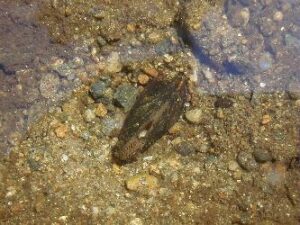(by Carol Foss)
For many people, mention of federally endangered wildlife species in New Hampshire evokes visions of Bald Eagles and Peregrine Falcons, or perhaps Piping Plovers. Few realize that the waters of the Connecticut and Ashuelot rivers harbor a globally endangered species – the dwarf wedgemussel. These inconspicuous mollusks once thrived in slow-moving streams and rivers from New Brunswick to North Carolina but are now extirpated from Canada and limited to scattered populations in seven drainages along the Atlantic Coast.

Dwarf wedgemussels occur on a variety of substrates, including sand, gravel, silt, and clay, in waters with slow to moderate flow. Their diet consists of phytoplankton, bacteria, and fine or dissolved organic matter filtered from the water. Like all mussels, they have a complicated life cycle. Eggs are fertilized while attached to the female’s gills and hatch into microscopic “glochidia,” which drop off and attach to the gills of a host fish where they form a cyst. After developing into juvenile mussels within the cysts, they drop to the bottom of the stream and grow into adults. While most of our native freshwater mussels are longer lived, adult dwarf wedgemussels only survive for about 10 years, so annual reproduction is important for maintaining a population.
Habitat degradation is an important threat to dwarf wedgemussel populations. Bridge removal and reconstruction projects on the Connecticut and Ashuelot rivers require surveys for this species. Biologists have transplanted colonies to locations upstream from construction sites on each of these rivers in recent years.
